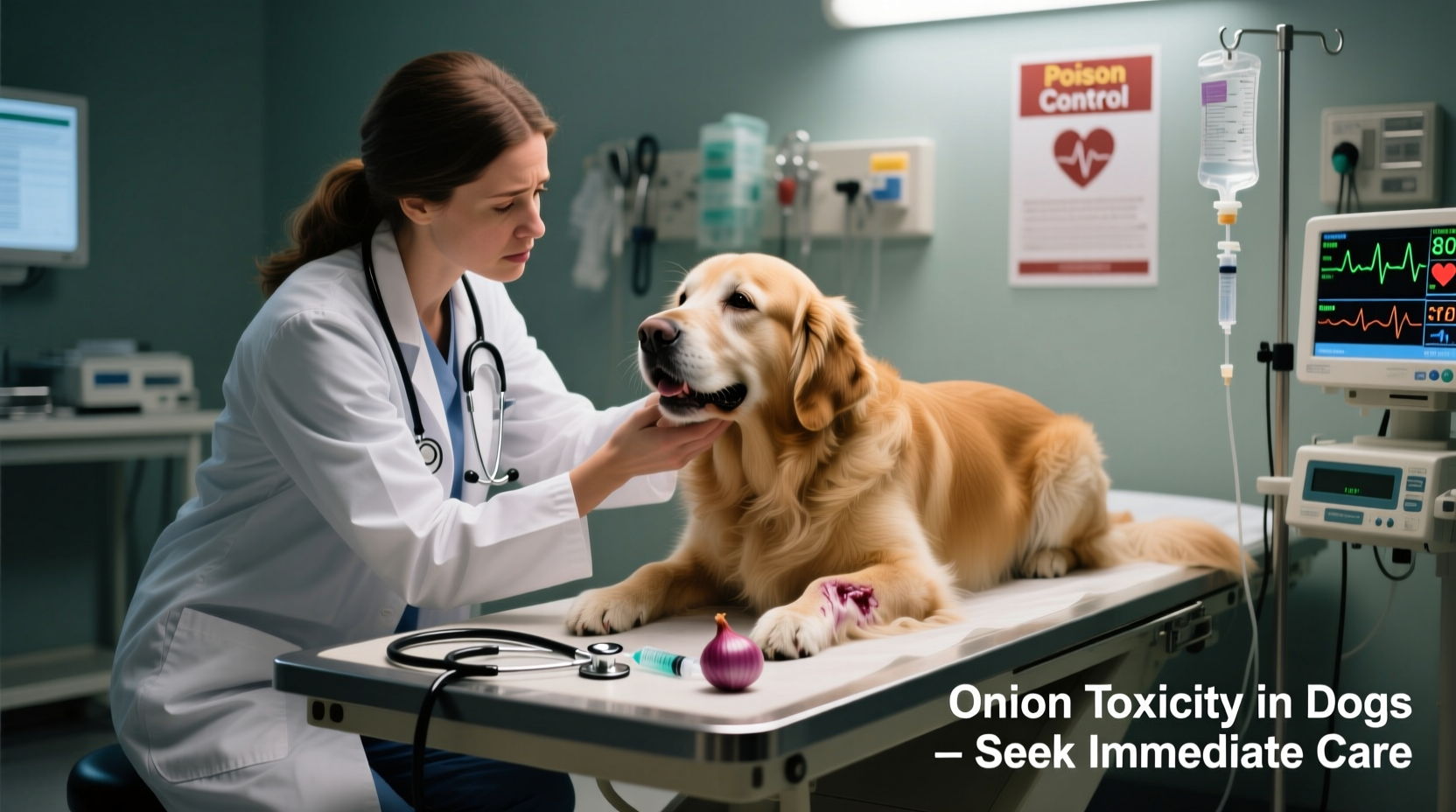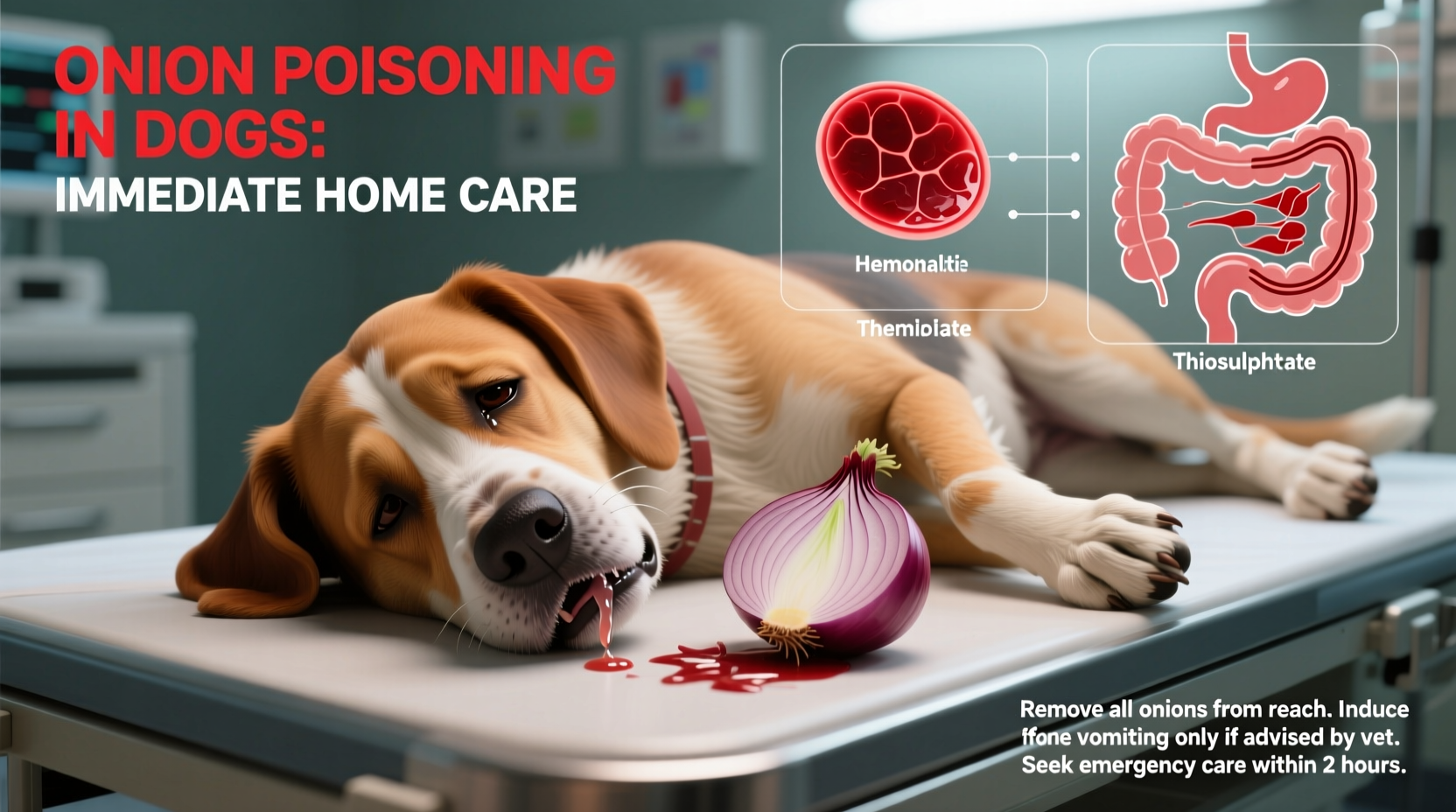Discovering your dog ate onions triggers urgent concern—and rightly so. Onion poisoning in dogs is a serious medical emergency that demands immediate professional intervention. While well-meaning pet owners often search for how to treat onion poisoning in dogs at home, the critical reality is that no safe or effective home treatment exists for this condition. This guide provides vet-verified information about what actually happens during onion toxicity, why professional care is non-negotiable, and the limited supportive steps you can take while rushing to the clinic.
Why Onion Poisoning Requires Veterinary Intervention
Onions contain N-propyl disulfide, a compound that destroys red blood cells in dogs, leading to hemolytic anemia. Unlike humans, dogs lack the enzyme system to safely process these compounds. When red blood cells rupture, hemoglobin floods the bloodstream, potentially causing kidney damage, organ failure, and death if untreated. The American Veterinary Medical Association confirms that all onion varieties—raw, cooked, powdered, or in broth—are toxic to dogs at doses as low as 15-30 grams per kilogram of body weight.
| Dog Weight | Minimum Toxic Dose | Equivalent Household Measure |
|---|---|---|
| 10 lbs (4.5 kg) | 68-135g | ½ cup chopped onions |
| 50 lbs (22.7 kg) | 340-680g | 2½ cups chopped onions |
| Any size | Any amount | Onion powder in baby food or soups |
This onion toxicity dose comparison chart from the ASPCA Animal Poison Control Center demonstrates why even small exposures warrant veterinary assessment. Note that concentrated forms like onion powder pose higher risks—just one teaspoon contains the equivalent of a whole onion.
Immediate Actions While En Route to the Vet
When you discover onion consumption, your actions in the first 30 minutes significantly impact outcomes. Follow this vet-approved protocol:
- Contact professionals immediately: Call your vet or the ASPCA Animal Poison Control Center (888-426-4435) with details about what your dog consumed, when, and their weight
- Preserve evidence: Save packaging or food remnants to help veterinarians determine exact onion content
- Time the exposure: Note exactly when ingestion occurred—this determines treatment options
- Prepare transport: Have a carrier ready and minimize your dog's activity to reduce oxygen demand
Crucially, do not induce vomiting at home unless specifically instructed by a veterinary professional. Improper induction can cause aspiration pneumonia or worsen chemical burns from certain onion compounds. The Merck Veterinary Manual emphasizes that only veterinarians should administer hydrogen peroxide or other emetics after evaluating your dog's specific condition.

Symptom Timeline: What to Monitor Before Arrival
Onion poisoning symptoms often appear deceptively late, creating dangerous false reassurance. Understanding this progression helps communicate critical information to your vet:
- 0-24 hours: Vomiting, diarrhea, abdominal pain (early gastrointestinal irritation)
- 24-72 hours: Lethargy, weakness, rapid breathing (onset of hemolytic anemia)
- 3-5 days: Pale gums, dark urine, jaundice (severe red blood cell destruction)
According to Cornell University's College of Veterinary Medicine, symptom severity doesn't correlate with onion quantity consumed. Some dogs develop life-threatening anemia after minimal exposure due to individual metabolic differences. Never assume "just a little" is safe—prompt veterinary assessment remains essential regardless of apparent symptoms.
What Veterinary Treatment Actually Involves
Understanding professional treatment protocols dispels dangerous misconceptions about home management. Veterinary care for onion poisoning follows this evidence-based sequence:
Phase 1: Decontamination (Within 2-4 Hours)
If ingestion occurred recently, vets may perform controlled vomiting induction using apomorphine, followed by activated charcoal administration to bind remaining toxins. This window closes quickly—after 4 hours, toxins have typically absorbed into the bloodstream.
Phase 2: Supportive Care (24-72 Hours)
Once absorbed, treatment focuses on managing complications:
- Intravenous fluid therapy to support kidney function
- Oxygen supplementation for severe anemia cases
- Blood transfusions in critical hemolysis situations
- Antioxidant therapy (like N-acetylcysteine) to protect remaining red blood cells
Phase 3: Monitoring & Recovery (Days 5-14)
Vets track complete blood counts daily until red blood cell production stabilizes. Full recovery typically takes 2-3 weeks, requiring strict rest and follow-up visits. The Journal of Veterinary Emergency and Critical Care notes that 95% of dogs survive with prompt professional treatment, compared to 40% mortality when care is delayed.
Preventing Future Onion Emergencies
Most onion poisonings occur accidentally through human food sharing. Implement these vet-recommended safeguards:
- Secure food storage: Keep onions in closed cabinets—not on countertops where dogs can access them
- Discard scraps safely: Use lidded outdoor trash cans for onion-containing food waste
- Check baby food labels: Many brands contain onion powder as flavoring
- Educate household members: Ensure everyone understands that no amount of onion is safe for dogs
Remember that garlic, leeks, chives, and shallots belong to the same Allium family and pose identical risks. The American Kennel Club reports these cause 30% of all vegetable-related poisonings in dogs—often from seemingly harmless foods like pizza crusts or salad dressings.
When Home Care Becomes Dangerous
Well-intentioned home remedies can worsen onion poisoning. Avoid these common but hazardous approaches:
- Milk or yogurt: Won't neutralize toxins and may worsen vomiting
- Activated charcoal from pharmacies: Requires precise dosing only vets can determine
- "Wait and see" approach: Delaying care until symptoms appear reduces treatment effectiveness
- Human medications: Acetaminophen or other drugs cause additional organ damage
The Veterinary Information Network stresses that onion poisoning treatment at home is impossible because it requires blood monitoring, intravenous medications, and equipment unavailable outside clinics. What looks like "just being cautious" could mean the difference between full recovery and fatal complications.











 浙公网安备
33010002000092号
浙公网安备
33010002000092号 浙B2-20120091-4
浙B2-20120091-4